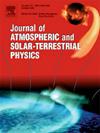CU-ST雷达在冬季和季风季节观测哈林哈塔(22.93°N, 88.50°E)低层大气重力波的变率
IF 1.9
4区 地球科学
Q3 GEOCHEMISTRY & GEOPHYSICS
Journal of Atmospheric and Solar-Terrestrial Physics
Pub Date : 2025-05-28
DOI:10.1016/j.jastp.2025.106557
引用次数: 0
摘要
重力波受浮力和重力的影响,在大气内的能量和动量传输中起着至关重要的作用。本研究利用位于印度西孟加拉邦哈林哈塔附近电离层场站的加尔各答大学平流层-对流层(CU ST)雷达的数据,研究了对流层上层和平流层下层的GWs的存在。利用2023年冬季(1月26日和2月8日)和季风季节(8月1日多雨季节和8月10日无雨季节)的雷达观测资料研究了GW特征。来自纬向、经向和垂直速度的波动被用于GW表征。通过柱状图分析估计了GW参数。使用Lomb-Scargle周期图来确定GW的优势周期。冬季以西风和南风为主,副热带西风急流延伸至约24 km高度,伴有显著的风切变。风切变驱动的GWs优势周期较短,水平波长较短。在季风时期,风型以热带偏东风急流为主,具有明显的逆风、强东风和垂直速度上明显的周期性上升气流和下降气流。与热带偏东急流和对流活动相关的风切变导致该地区强GW活动。在这个季节,GWs的优势周期相对较高,水平波长相对较长,特别是在雨天。本文章由计算机程序翻译,如有差异,请以英文原文为准。
Variability of lower atmospheric gravity waves observed over Haringhata (22.93° N, 88.50° E) during winter and monsoon seasons through CU-ST Radar
Gravity waves (GWs), influenced by buoyancy and gravity, play a vital role in energy and momentum transport within the atmosphere. The present study examined the presence of GWs in the upper troposphere and lower stratosphere using data from the Calcutta University Stratosphere-Troposphere (CU ST) Radar located at the Ionosphere Field Station near Haringhata, West Bengal, India. GW characteristics were studied from radar observations during the winter (January 26 and February 8) and monsoon (rainy August 1 and non-rainy August 10) seasons of 2023. Fluctuations from zonal, meridional, and vertical velocities were utilized for GW characterization. GW parameters were estimated through hodograph analysis. The Lomb-Scargle periodogram was used to identify dominant periods of GW. Predominant westerly and southerly winds were noticed in winter, with notable wind shear associated with the subtropical westerly jet extending up to about 24 km altitude. The wind shear-driven GWs with comparatively lower dominant periods and shorter horizontal wavelengths was observed during this season. In monsoon, wind patterns were dominated by the tropical easterly jet, featuring considerable wind reversals, strong easterly winds, and noticeable periodic updrafts and downdrafts in vertical velocities. Wind shear associated with the tropical easterly jet and convective activities resulted in strong GW activity over this region. During this season, GWs with comparatively higher dominant periods and longer horizontal wavelengths were noticed, particularly on the rainy day.
求助全文
通过发布文献求助,成功后即可免费获取论文全文。
去求助
来源期刊

Journal of Atmospheric and Solar-Terrestrial Physics
地学-地球化学与地球物理
CiteScore
4.10
自引率
5.30%
发文量
95
审稿时长
6 months
期刊介绍:
The Journal of Atmospheric and Solar-Terrestrial Physics (JASTP) is an international journal concerned with the inter-disciplinary science of the Earth''s atmospheric and space environment, especially the highly varied and highly variable physical phenomena that occur in this natural laboratory and the processes that couple them.
The journal covers the physical processes operating in the troposphere, stratosphere, mesosphere, thermosphere, ionosphere, magnetosphere, the Sun, interplanetary medium, and heliosphere. Phenomena occurring in other "spheres", solar influences on climate, and supporting laboratory measurements are also considered. The journal deals especially with the coupling between the different regions.
Solar flares, coronal mass ejections, and other energetic events on the Sun create interesting and important perturbations in the near-Earth space environment. The physics of such "space weather" is central to the Journal of Atmospheric and Solar-Terrestrial Physics and the journal welcomes papers that lead in the direction of a predictive understanding of the coupled system. Regarding the upper atmosphere, the subjects of aeronomy, geomagnetism and geoelectricity, auroral phenomena, radio wave propagation, and plasma instabilities, are examples within the broad field of solar-terrestrial physics which emphasise the energy exchange between the solar wind, the magnetospheric and ionospheric plasmas, and the neutral gas. In the lower atmosphere, topics covered range from mesoscale to global scale dynamics, to atmospheric electricity, lightning and its effects, and to anthropogenic changes.
 求助内容:
求助内容: 应助结果提醒方式:
应助结果提醒方式:


